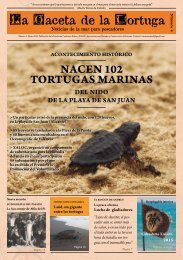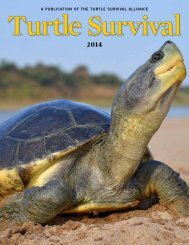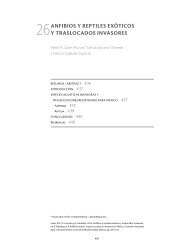tsrp63entire
tsrp63entire
tsrp63entire
Create successful ePaper yourself
Turn your PDF publications into a flip-book with our unique Google optimized e-Paper software.
5.3.3 Topic 16—Species ecology and population modelling<br />
An understanding of the interactions between a species and its living and non-living<br />
environment is critical for managing species recovery. Knowledge of the biological requirements,<br />
life-history parameters, population dynamics and behaviour of native frogs is essential for<br />
the assessment of habitat suitability and the identification of factors restricting population<br />
growth. This information is also integral to developing realistic population models to assess the<br />
outcomes of various management scenarios.<br />
Current knowledge of the biological requirements (including habitat requirements) of native<br />
frogs is lacking. The main stronghold populations of native frogs are found in unmodified forest<br />
habitats and this was thought to reflect their habitat requirements. However, native frogs can also<br />
persist in some highly modified environments (Brown 2000; Bell et al. 2004c), which suggests<br />
that the current distribution of native frogs may not reflect the full range, or even optimal, native<br />
frog habitat.<br />
It is of increasing importance that we understand the habitat requirements and life-history<br />
parameters of native frogs, as translocation is becoming a key tool for the management of<br />
these species. A good understanding of their habitat requirements is essential for assessing the<br />
suitability of new sites for translocation, while knowledge of life-history parameters is required to<br />
assess the viability of new or small populations.<br />
Issues<br />
Issue 16.1:<br />
Issue 16.2:<br />
Many of the life-history characteristics of native frogs that are necessary for<br />
developing population models (e.g. frequency of breeding, age-specific fecundity)<br />
are unknown.<br />
Key information about native frog behaviour and microhabitat requirements<br />
(e.g. egg-laying sites, seasonal refuges, juvenile habitat requirements, UV exposure,<br />
environmental cues) is not available. Therefore, microhabitat suitability at existing<br />
sites, or for the establishment of new sites, can not be accurately determined.<br />
Objectives and actions<br />
Objective 16.1:<br />
Objective 16.2:<br />
To ensure that the information that is required to construct robust population<br />
models is available and that population modelling is undertaken for all taxa.<br />
To increase our understanding of the suitability of microhabitats for the<br />
establishment and maintenance of native frog populations.<br />
Action Accountability Priority<br />
16.1 Facilitate research into the biology and ecology<br />
(e.g. breeding biology, communication, growth<br />
rate, mortality rate) of native frogs throughout the<br />
term of this plan.<br />
16.2 Develop population models using knowledge of<br />
the biology and ecology of species to determine<br />
the long-term viability of small, isolated or<br />
translocated frog populations by 2018.<br />
Science and Capability Group<br />
Relevant Chief Rangers and Senior Rangers<br />
Science and Capability Group<br />
Recovery Group<br />
Captive institutions<br />
Essential<br />
Essential<br />
30 Bishop et al.—Native frog recovery plan, 2013–2018





